Understanding Dynamics of Mangrove Forest on Protected Areas of Hainan Island, China: 30 Years of Evidence from Remote Sensing
Abstract
1. Introduction
2. Materials and Methods
2.1. Study Area and Data Sets
2.1.1. Study Area
2.1.2. Data Sets
2.2. Understnading Mangrove Dynamics thorugh the PSR Framework
2.3. Remote Sensing Data Processing
2.4. Accuracy Assessment
3. Results
3.1. Accuracy Assessment of Mangrove Areas
3.2. The Distribution of Mangrove Areas on Selected Protected Areas of Hainan Island
4. Discussion
4.1. Accuracy of Multitemporal Mangrove Dynamics Mapping
4.2. Trends in the Area of Mangrove Forest at Selected Sites on Hainan Island
4.3. Pressures and Responses to Mangrove Changes on Selected Protected Areas of Hainan Island
4.4. Options for Sustainable Mangroves Management on Hainan Island
5. Conclusions
Supplementary Materials
Author Contributions
Funding
Acknowledgments
Conflicts of Interest
References
- Giri, C.; Ochieng, E.; Tieszen, L.L.; Zhu, Z.; Singh, A.; Loveland, T.; Masek, J.; Duke, N. Status and distribution of mangrove forests of the world using earth observation satellite data. Glob. Ecol. Biogeogr. 2011, 20, 154–159. [Google Scholar] [CrossRef]
- Lugo, A.E.; Snedaker, S.C. The Ecology of Mangroves. Annu. Rev. Ecol. Syst. 1974, 5, 39–64. [Google Scholar] [CrossRef]
- Lin, P. Mangrove Ecosystem in China; Science Press: Beijing China, 1997. (In Chinese) [Google Scholar]
- Zhang, Q.M.; Zhang, Y.C. Study on Biogeomorphologic Process of Mangrove Coasts in South China. Quat. Sci. 1997, 17, 344–353. (In Chinese) [Google Scholar]
- Lin, P. A Review on the Mangrove Research in China. J. Xiamen Univ. (Nat. Sci.) 2001, 2, 592–603. (In Chinese) [Google Scholar]
- Glaser, M. Interrelations between mangrove ecosystem, local economy and social sustainability in Caeté Estuary, North Brazil. Wetl. Ecol. Manag. 2003, 11, 265–272. [Google Scholar] [CrossRef]
- Mumby, P.J. Connectivity of reef fish between mangroves and coral reefs: Algorithms for the design of marine reserves at seascape scales. Biol. Conserv. 2006, 128, 215–222. [Google Scholar] [CrossRef]
- Giri, C. Observation and Monitoring of Mangrove Forests Using Remote Sensing: Opportunities and Challenges. Remote Sens. 2016, 8, 783. [Google Scholar] [CrossRef]
- Alongi, D.M. Mangrove forests: Resilience, protection from tsunamis, and responses to global climate change. Estuar. Coast. Shelf Sci. 2008, 76, 1–13. [Google Scholar] [CrossRef]
- Donato, D.C.; Kauffman, J.B.; Murdiyarso, D.; Kurnianto, S.; Stidham, M.; Kanninen, M. Mangroves among the most carbon-rich forests in the tropics. Nat. Geosci. 2011, 4, 293–297. [Google Scholar] [CrossRef]
- Blasco, F.; Aizpuru, M.; Gers, C. Depletion of the mangroves of Continental Asia. Wetl. Ecol. Manag. 2001, 9, 255–266. [Google Scholar] [CrossRef]
- Metternicht, G.; Lucas, R.; Bunting, P.; Held, A.; Lymburner, L.; Ticehurst, C. Addressing mangrove protection in Australia: The contribution of Earth observation technologies. In Proceedings of the IGARSS 2018, Valence, Spain, 22–27 July 2018; pp. 6548–6551. [Google Scholar]
- Pastor-Guzman, J.; Dash, J.; Atkinson, P.M. Remote sensing of mangrove forest phenology and its environmental drivers. Remote Sens. Environ. 2018, 205, 71–84. [Google Scholar] [CrossRef]
- Oostdijk, M.; Santos, M.J.; Whigham, D.; Verhoeven, J.; Silvestri, S. Assessing rehabilitation of managed mangrove ecosystems using high resolution remote sensing. Estuar. Coast. Shelf Sci. 2018, 211, 238–247. [Google Scholar] [CrossRef]
- Zhang, K.; Thapa, B.; Ross, M.; Gann, D. Remote sensing of seasonal changes and disturbances in mangrove forest: A case study from South Florida. Ecosphere 2016, 7, e01366. [Google Scholar] [CrossRef]
- Everitt, J.H.; Yang, C.; Sriharan, S.; Judd, F.W. Using high resolution satellite imagery to map black mangrove on the Texas Gulf Coast. J. Coast. Res. 2008, 24, 1582–1586. [Google Scholar] [CrossRef]
- Giri, C.; Pengra, B.; Zhu, Z.; Singh, A.; Tieszen, L.L. Monitoring Mangrove forest dynamics of the Sundarbans in Bangladesh and India using multi-temporal satellite data from 1973 to 2000 satellite data from 1973 to 2000. Estuar. Coast. Shelf Sci. 2007, 73, 91–100. [Google Scholar] [CrossRef]
- Kuenzer, C.; Bluemel, A.; Gebhardt, S.; Quoc, T.V.; Dech, S. Remote sensing of mangrove ecosystems: A review. Remote Sens. 2011, 3, 878–928. [Google Scholar] [CrossRef]
- Green, E.P.; Mumby, P.J.; Edwards, A.J.; Clark, C.D.; Ellis, A.C. The assessment of mangrove areas using high resolution multispectral airborne imagery. J. Coast. Res. 1998, 14, 433–443. [Google Scholar]
- Kasischke, E.S.; Melack, J.M.; Dobson, M.C. The Use of Imaging Radars for Ecological Applications—A Review. Remote Sens. Environ. 1997, 59, 141–156. [Google Scholar] [CrossRef]
- Valiela, I.; Bowen, J.L.; York, J.K. Mangrove forests: One of the world’s threatened major tropical environments. Bioscience 2001, 51, 807–815. [Google Scholar] [CrossRef]
- FAO. The World’s Mangroves 1980–2005; FAO Forestry Paper 153; FAO: Rome, Italy, 2007; Available online: Ftp://ftp.fao.org/docrep/fao/010/a1427e/a1427e00.pdf (accessed on 30 October 2009).
- Spalding, M.; Kainuma, M.; Collins, L. World atlas of mangroves. In World Atlas of Mangroves; Routledge: London, UK, 2010. [Google Scholar]
- Hamilton, S.E.; Casey, D. Creation of a high spatio-temporal resolution global database of continuous mangrove forest cover for the 21st century (CGMFC-21). Glob. Ecol. Biogeogr. 2016, 25, 729–738. [Google Scholar] [CrossRef]
- Chen, L.; Wang, W.; Zhang, Y.; Lin, G. Recent progresses in mangrove conservation, restoration and research in China. J. Plant Ecol. 2009, 2, 45–54. [Google Scholar] [CrossRef]
- Jia, M.; Wang, Z.; Li, L.; Song, K.; Ren, C.; Liu, B.; Mao, D. Mapping China’s mangroves based on an object-oriented classification of Landsat imagery. Wetlands 2014, 34, 277–283. [Google Scholar] [CrossRef]
- Lee, T.; Yeh, H. Applying remote sensing techniques to monitor shifting wetland vegetation: A case study of Danshui River estuary mangrove communities, Taiwan. Ecol. Eng. 2009, 35, 487–496. [Google Scholar] [CrossRef]
- Li, M.S.; Mao, L.J.; Shen, W.J.; Liu, S.Q.; Wei, A.S. Change and fragmentation trends of Zhejiang mangrove forests in Southern China using multi-temporal Landsat imagery (1977–2010). Estuar. Coast. Shelf Sci. 2013, 130, 111–120. [Google Scholar] [CrossRef]
- Li, C.; Dai, H. Extraction of mangroves spatial distribution using remotely sensed data. Wetl. Sci. 2014, 12, 580–589. (In Chinese) [Google Scholar]
- Wu, P.; Ma, Y.; Li, X.; Yu, G. Remote sensing monitoring of the mangrove forests resources of Guangdong Province. J. Mar. Sci. 2011, 29, 16–24. (In Chinese) [Google Scholar]
- Zhang, W.; Chen, Z.; Wang, J. Monitoring the area variation of mangrove in Beibu Gulf Coast of Guangxi China with remote sensing data. J. Guangxi Univ. (Nat. Sci. Ed.) 2015, 40, 1570–1576. (In Chinese) [Google Scholar]
- Wang, T.; Zhang, H.; Lin, H.; Fang, C. Textural-spectral feature-based species classification of mangroves in Mai Po nature reserve from worldview-3 imagery. Remote Sens. 2016, 8, 24. [Google Scholar] [CrossRef]
- Wu, P.; Zhang, J.; Ma, Y.; Li, X. Remote sensing monitoring and analysis of the changes of mangrove resource in China in the past 20 years. Adv. Mar. Sci. 2013, 31, 406–414. (In Chinese) [Google Scholar]
- Chen, B.; Xiao, X.; Li, X.; Pan, L.; Doughty, R.; Ma, J.; Dong, J.; Qin, Y.; Zhao, B.; Wu, Z.; et al. A mangrove forest map of China in 2015: Analysis of time series Landsat 7/8 and Sentinel-1A imagery in Google Earth Engine cloud computing platform. ISPRS J. Photogramm. Remote Sens. 2017, 131, 104–120. [Google Scholar] [CrossRef]
- Wang, W.; Wang, M. The mangroves of China; Science Press: Beijing, China, 2007. (In Chinese) [Google Scholar]
- Tu, Z.; Chen, X.; Wu, R. Status of mangrove resources in mangrove nature reserves of Hainan Province. Dev. Manag. Mar. 2015, 32, 90–92. (In Chinese) [Google Scholar]
- Wu, R.; Chen, X.; Tu, Z.; Wang, D. Current status of mangrove community in Caiqiao of Hainan Province. Trop. Agric. Eng. 2017, 41, 82–84. (In Chinese) [Google Scholar]
- Wu, R.; Chen, X.; Chen, D.; Tu, Z.; Zhang, G.; Wang, D. Investigation on current status of mangrove resources in Xinying Bay of Hainan Province. Chin. J. Trop. Agric. 2016, 36, 35–37. (In Chinese) [Google Scholar]
- Working Group of Dongzhaigang National Nature Reserve management bureau. Hainan Dongzhaigang National Nature Reserve Master Plan (2011~2020); Working Group of Dongzhaigang National Nature Reserve management bureau: Haikou, China, 2011. (In Chinese) [Google Scholar]
- Working Group of Dongzhaigang National Nature Reserve management bureau. Hainan Qinglangang National Nature Reserve Master Plan (2016~2020); Working Group of Dongzhaigang National Nature Reserve management bureau: Haikou, China, 2015. (In Chinese) [Google Scholar]
- USGS. Earth Resources Observation and Science Center. Available online: http://glovis.usgs.gov (accessed on 18 September 2015).
- Lovelock, C.E.; Cahoon, D.R.; Friess, D.A.; Guntenspergen, G.R.; Krauss, K.W.; Reef, R.; Rogers, K.; Saunders, M.L.; Sidik, F.; Swales, A.; et al. The vulnerability of Indo-Pacific mangrove forests to sea-level rise. Nature 2015, 526, 559–563. [Google Scholar] [CrossRef] [PubMed]
- Duke, N.C.; Kovacs, J.M.; Griffith, A.; Preece, L.; Hill, D.J.; van Oosterzee, P.; Mackenzie, J.; Morning, H.S.; Burrows, D. Large-scale dieback of mangroves in Australia’s Gulf of Carpentaria: A severe ecosystem response, coincidental with an unusually extreme weather event. Mar. Freshw. Res. 2017, 68, 1816–1829. [Google Scholar] [CrossRef]
- Ball, M.C. Ecophysiology of mangroves. Trees 1988, 2, 129–142. [Google Scholar] [CrossRef]
- UNDP-GEF. Strengthening the Management Effectiveness of the Wetland Protected Area System in Hainan for Conservation of Globally Significant Biodiversity. Project Document. 234 pages. 2013. Available online: https://info.undp.org/docs/pdc/Documents/CHN/Hainan%20Prodoc%20signed-82277.pdf (accessed on 27 June 2019).
- Roy, D.P.; Wulder, M.A.; Loveland, T.R.; Woodcock, C.E.; Allen, R.G.; Anderson, M.C.; Helder, D.; Irons, J.R.; Johnson, D.M.; Kennedy, R. Landsat-8: Science and product vision for terrestrial global change research. Remote Sens. Environ. 2014, 145, 154–172. [Google Scholar] [CrossRef]
- Andrew, A.M. An Introduction to Support Vector Machines and other kernel-based learning methods. Kybernetes 2001, 32, 1–28. [Google Scholar]
- Yao, Y.J.; Zhang, Z.X.; Qin, Q.M.; Qiu, Y.F. Study on wetland information extraction of remote sensing images based on support vector machine. Appl. Res. Comput. 2008, 25, 989–990. (In Chinese) [Google Scholar]
- Wang, Z.W.; Sun, J.J.; Yu, Z.Y.; Bu, Y.Y. Review of remote sensing image classification based on support vector machine. Comput. Sci. 2016, 43, 11–17. (In Chinese) [Google Scholar]
- Zhang, C.; Zang, S.Y.; Jin, Z.; Zhang, Y.H. Remote sensing classification for Zhalong wetlands based on support vector machine. Wetl. Sci. 2011, 9, 263–269. (In Chinese) [Google Scholar]
- Lesiv, M.; See, L.; Juan Laso Bayas, J.; Sturn, T.; Schepaschenko, D.; Karner, M.; Moorthy, I.; McCallum, I.; Fritz, S. Characterizing the spatial and temporal availability of very high resolution satellite imagery in google earth and microsoft bing maps as a source of reference data. Land 2018, 7, 118. [Google Scholar] [CrossRef]
- Bey, A.; Sánchez-Paus Díaz, A.; Maniatis, D.; Marchi, G.; Mollicone, D.; Ricci, S.; Bastin, J.F.; Moore, R.; Federici, S.; Rezende, M.; et al. Collect earth: Land use and land cover assessment through augmented visual interpretation. Remote Sens. 2016, 8, 807. [Google Scholar] [CrossRef]
- Buja, K.; Menza, C. Sampling design tool for ArcGIS: Instruction manual. [for ESRI ArcGIS 10.0 Service Pack 3 or higher]. Available online: https://coastalscience.noaa.gov/project/sampling-design-tool-arcgis/ (accessed on 30 October 2015).
- Zhang, H. Remote Sensing Monitoring and Driven Force Analysis of Mangroves Change in Hainan Island during Nearly 30 Years. Master’s Thesis, Institute of Remote Sensing and Digital Earth, Chinese Academy of Sciences, Beijing, China, 2015. (In Chinese). [Google Scholar]
- Sun, Y.; Liao, B.; Guan, W.; Wang, R.; Ding, D.; Zhong, C. Spatial patterns and environmental factors of rapidly degraded mangroves at Dongzhaigang Harbor in Hainan. J. South China Agric. Univ. 2015, 36, 111–118. (In Chinese) [Google Scholar]
- Wang, J.; Wang, P.; Fu, X.; Zhao, Z.; Qiu, P.; Ji, Y.; Wu, D. Distribution and enrichment of heavy metals in mangrove wetland sediments and plants from Dongzhai harbor. Southwest China J. Agric. Sci. 2018, 31, 611–618. (In Chinese) [Google Scholar]
- Wang, L.; Li, Z.; Pu, Y.; Liao, W.; Zhang, Q.; Yu, K.; Zhao, H. Health evaluation of mangrove community in Dongzhaigang, Sanyahe, and Qingmeigang Mangrove Nature Reserves of Hainan Province. J. Trop. Oceanogr. 2011, 30, 81–86. (In Chinese) [Google Scholar]
- Fan, H. Protecting and developing mangrove forests in China—Enlightenment from tsunami and Typhoon. South. Land Resour. 2005, 10, 18–20. (In Chinese) [Google Scholar]
- Xu, D.; Liao, B.; Zhu, N.; Guan, W.; Li, S.; Zhong, C. A primary analysis on mangrove degradation in Dongzhaigang of Hainan Island. Ecol. Sci. 2014, 33, 294–300. (In Chinese) [Google Scholar]
- Hu, Z.; Xu, Y. Field Survey and Analysis of the Impact of Typhoon Activity on the Mangroves in Bamenwan in 2014; Fujian Quality Management: Fuzhou, China, 2017; p. 15. (In Chinese) [Google Scholar]
- Qiu, M.; Wang, R.; Ding, D.; Mao, J.; Liao, B. Impact of “Rammasun” on mangrove communities in Dongzhaigang, Hainan. Ecol. Sci. 2016, 35, 118–122. (In Chinese) [Google Scholar]
- Ren, J.; Weng, C.; Zhang, L. Impact of “Rammasun” on the garden trees in Hainan cities. Xiandai Hortic. 2015, 8, 99–101. (In Chinese) [Google Scholar]
- Ma, W.; Wang, M.; Wang, W.; Liu, Y.; Luo, L.; Tang, C. Biodiversity of mangrove mollusks in the west coast of Hainan Island, China. Biodivers. Sci. 2018, 26, 707–716. (In Chinese) [Google Scholar] [CrossRef]
- Liu, Y.; Song, C. Aquaculture development in coastal areas of Hainan Province. Ocean Dev. Manag. 2014, 5, 90–93. (In Chinese) [Google Scholar]
- The Policy of the Chinese Government. Suggestions on Promoting the Construction and Development of Hainan International Tourism Island; Issued by the State Council [2009] No.44 Documentary. Available online: https://baike.baidu.com/item/ (accessed on 30 July 2019). (In Chinese).
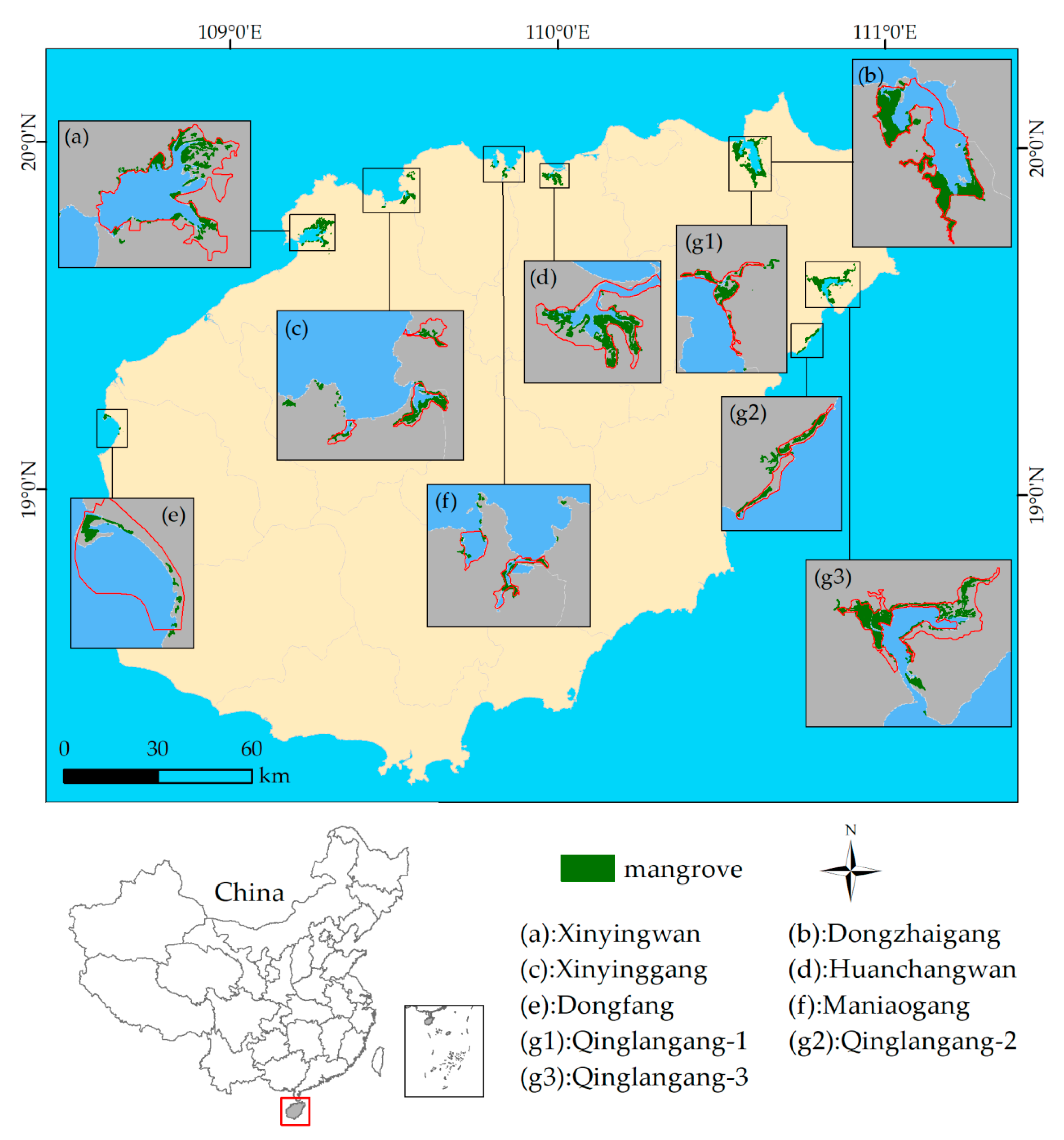
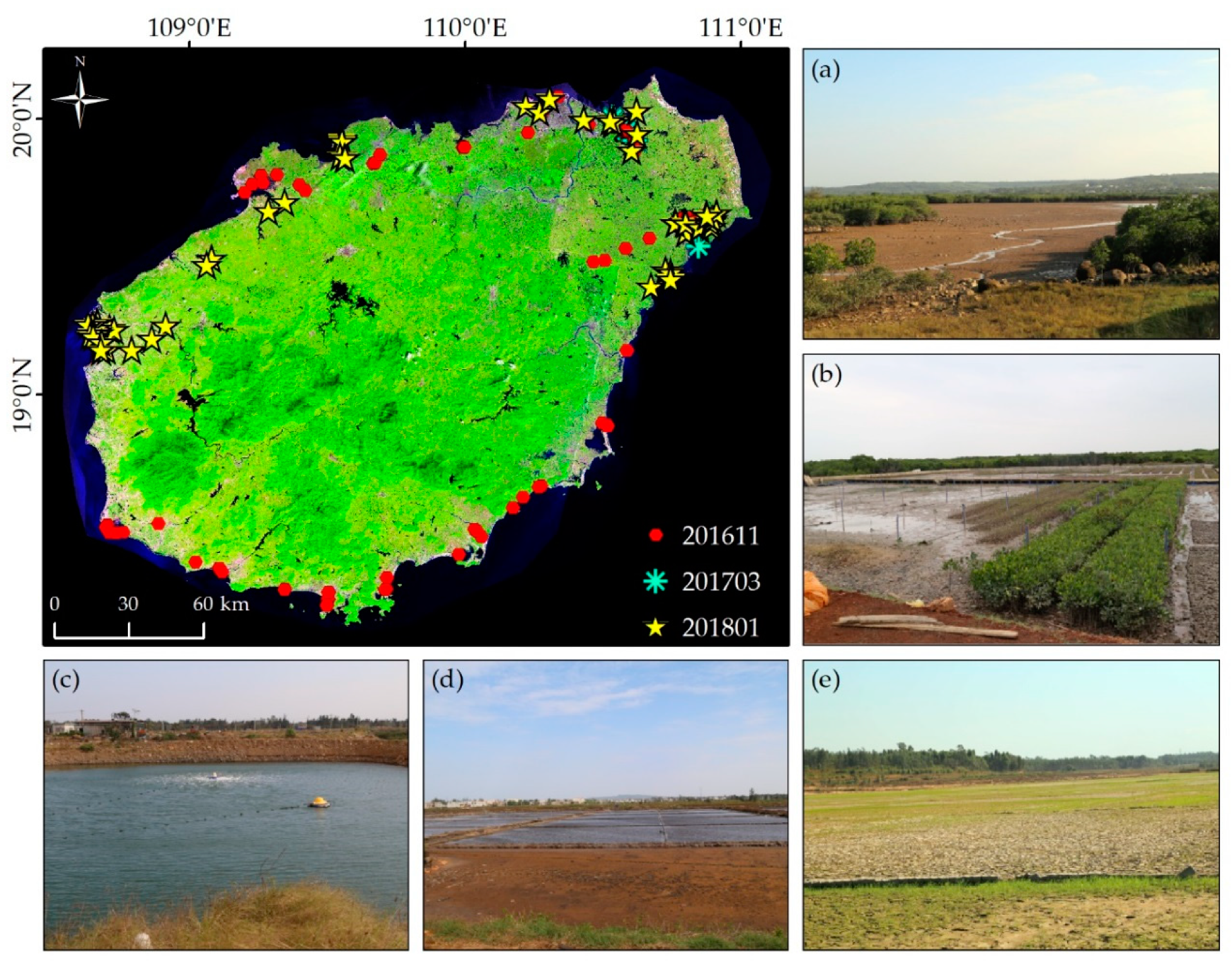
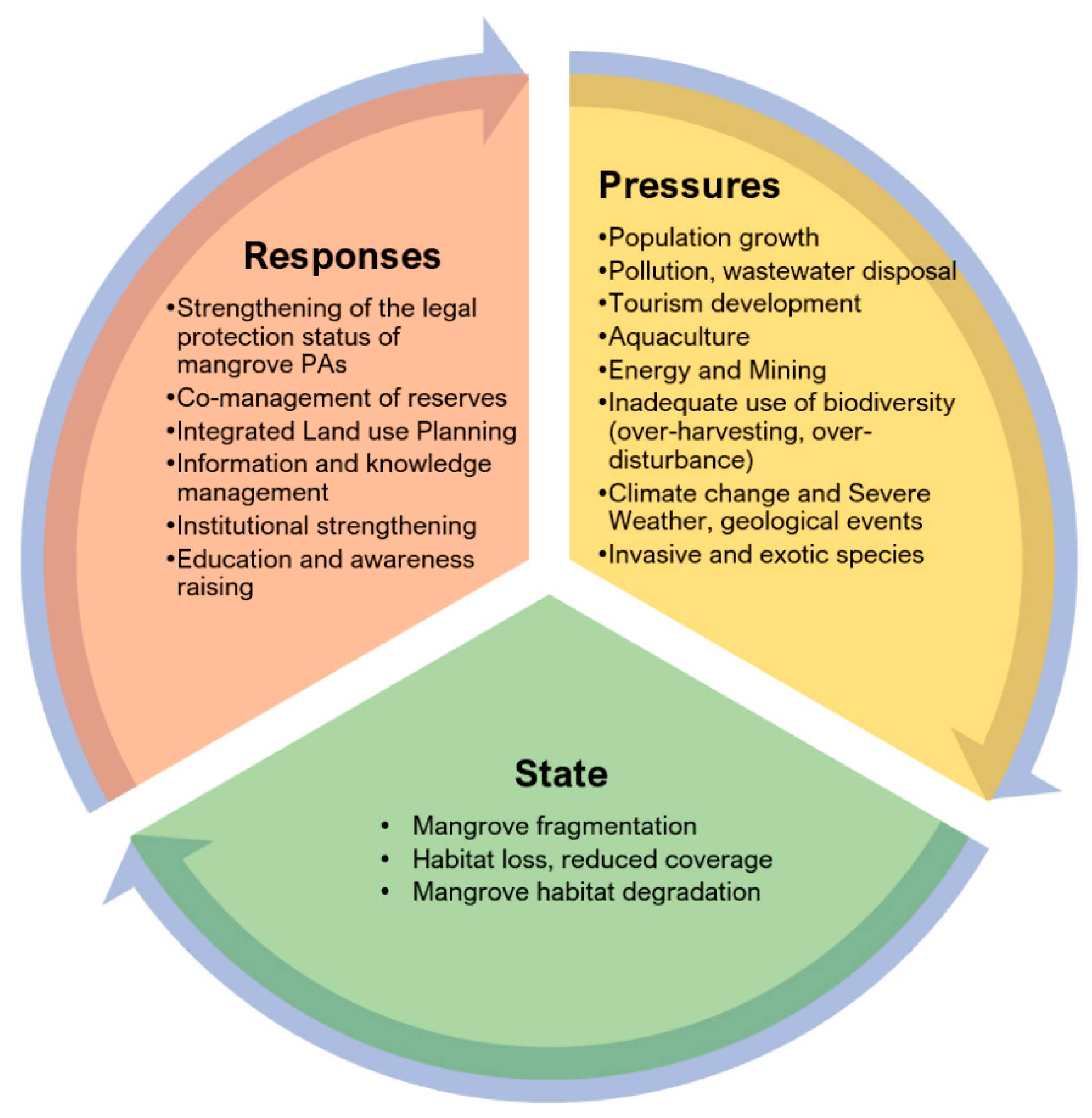
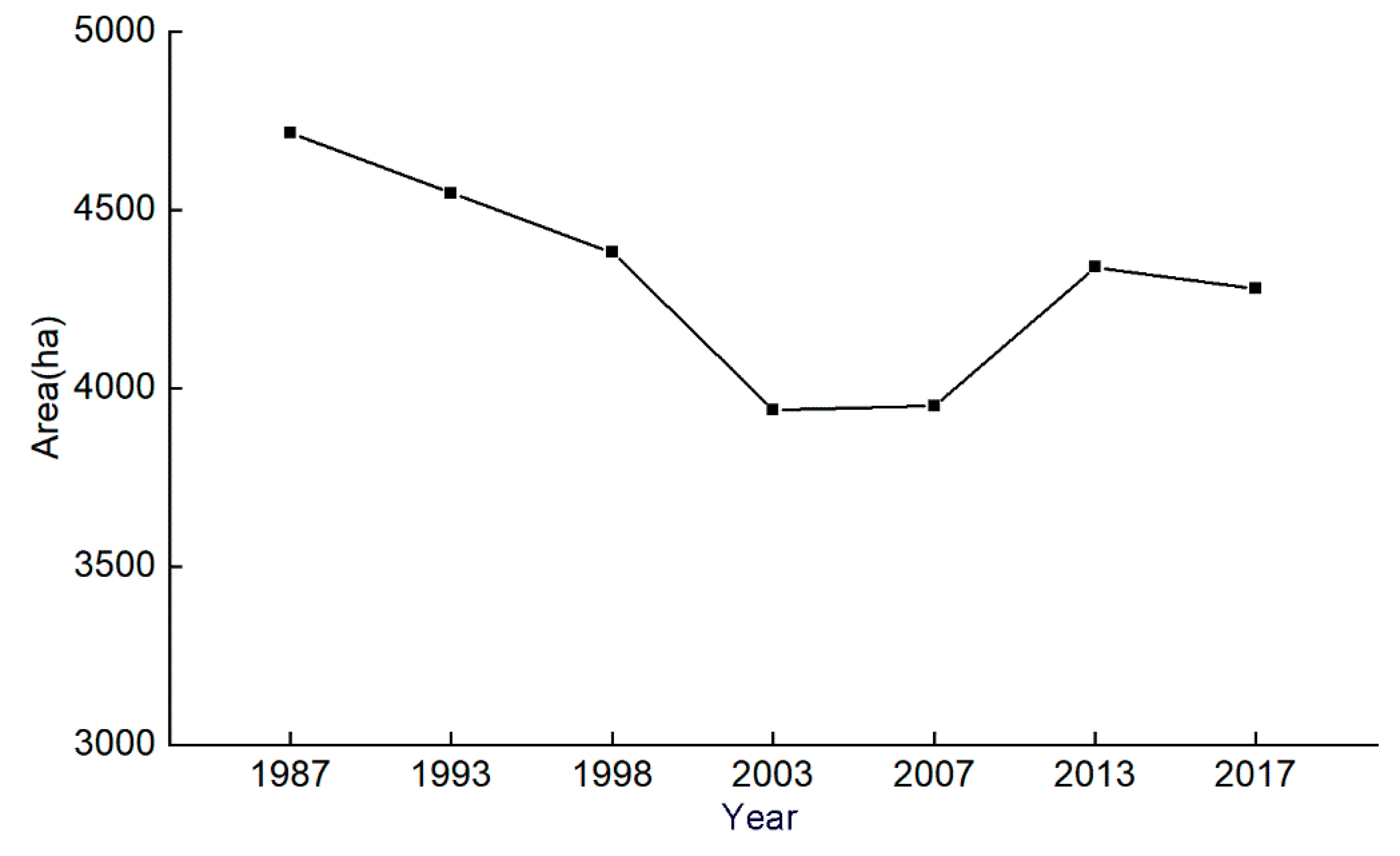
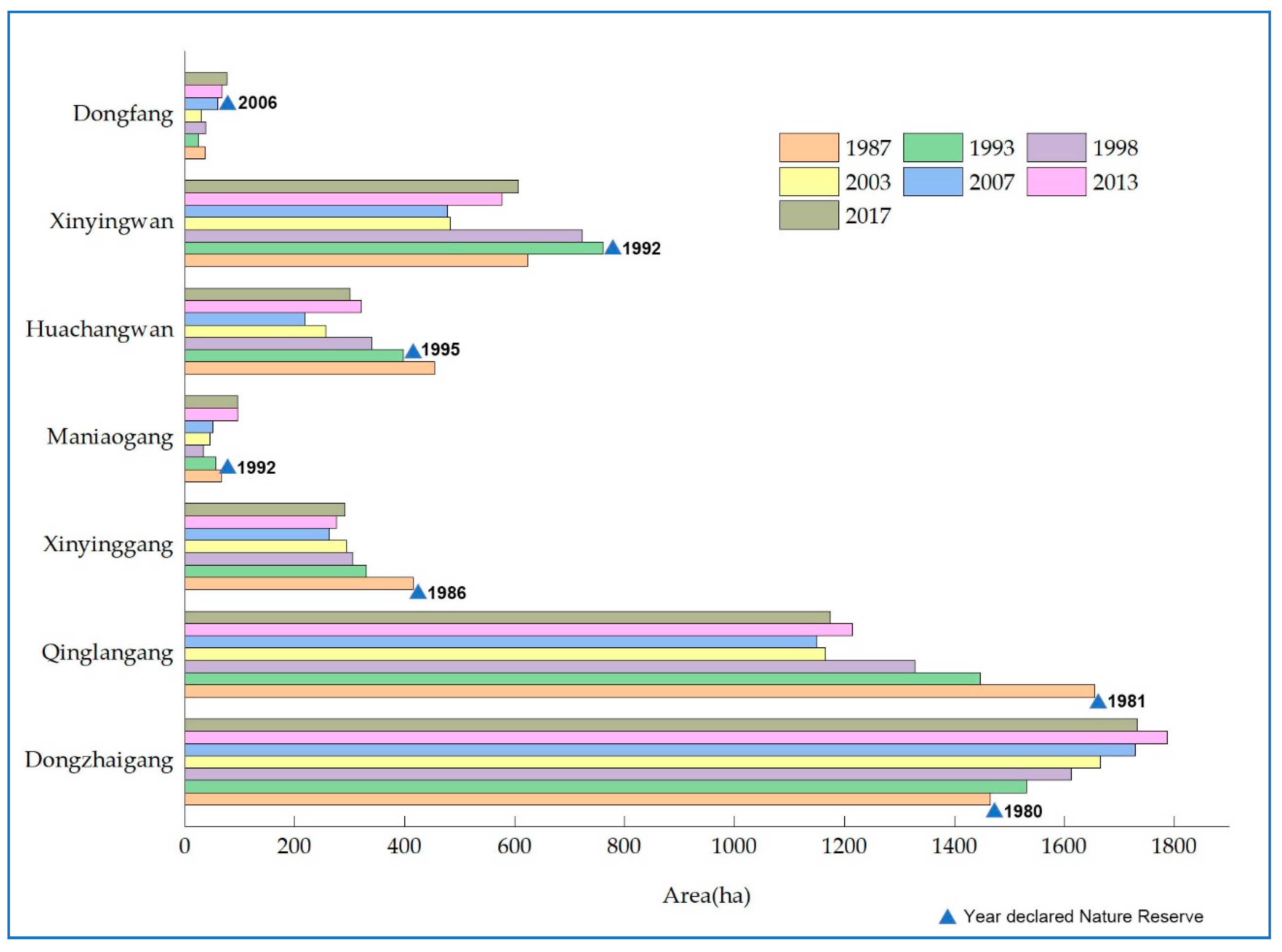
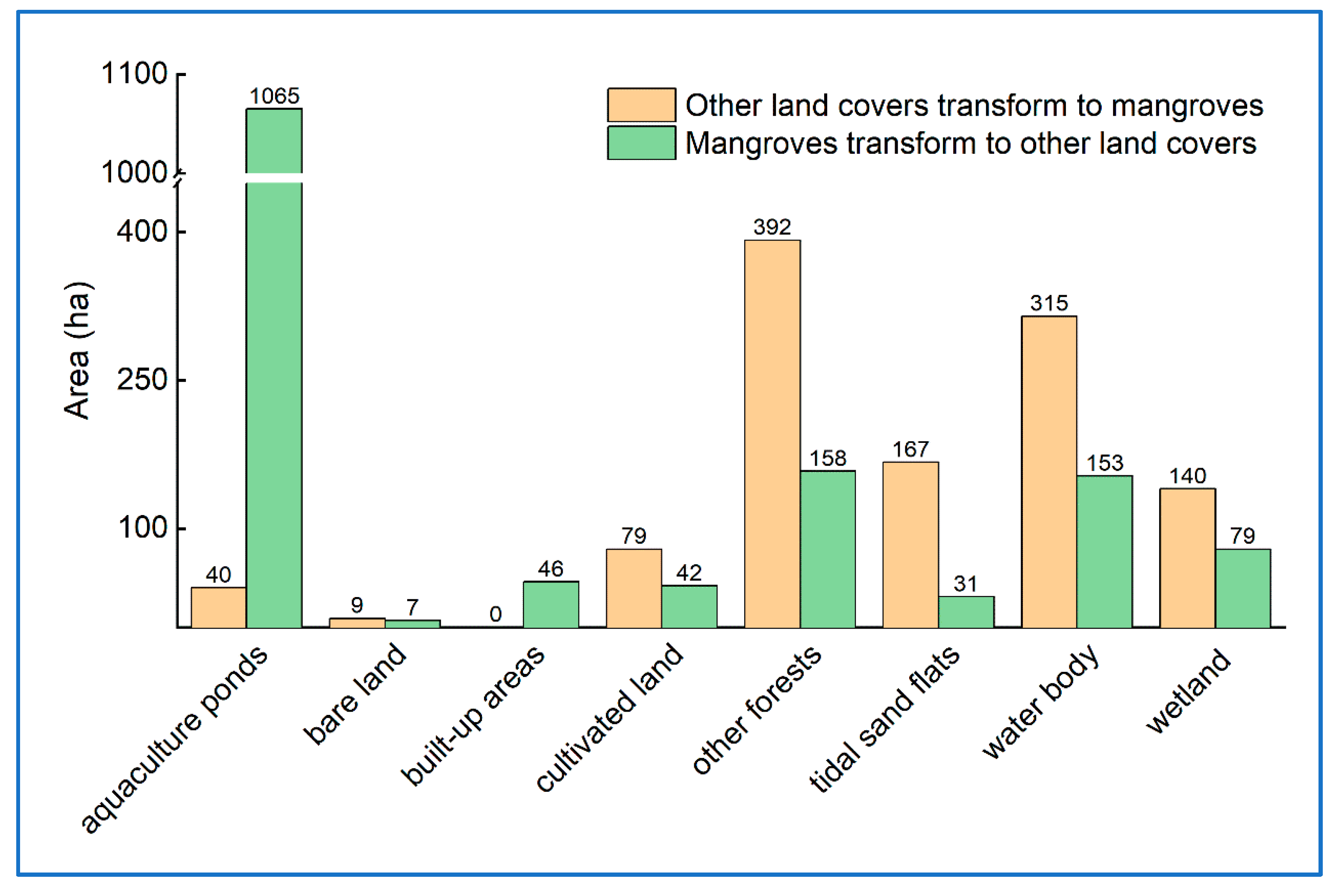
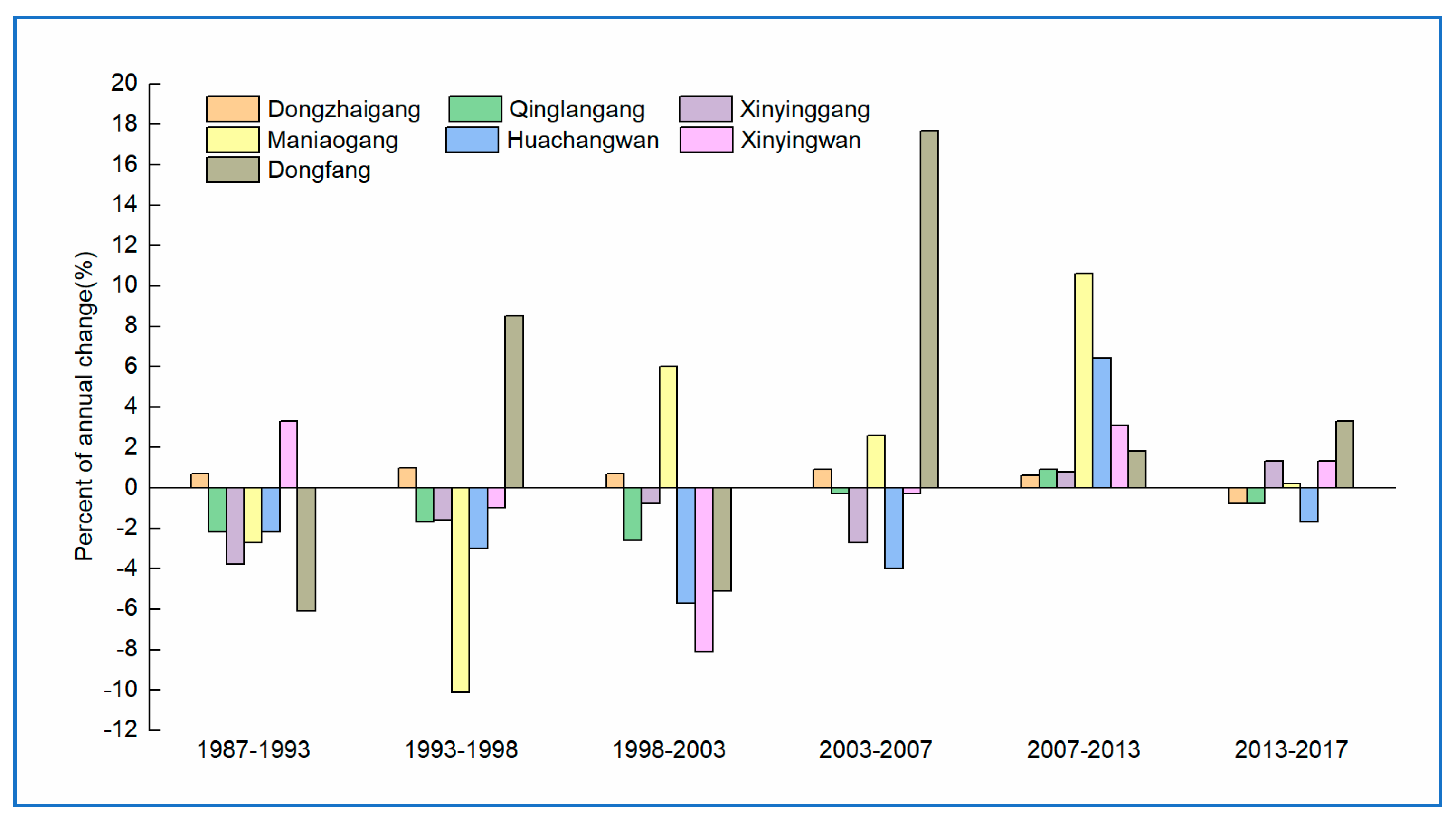
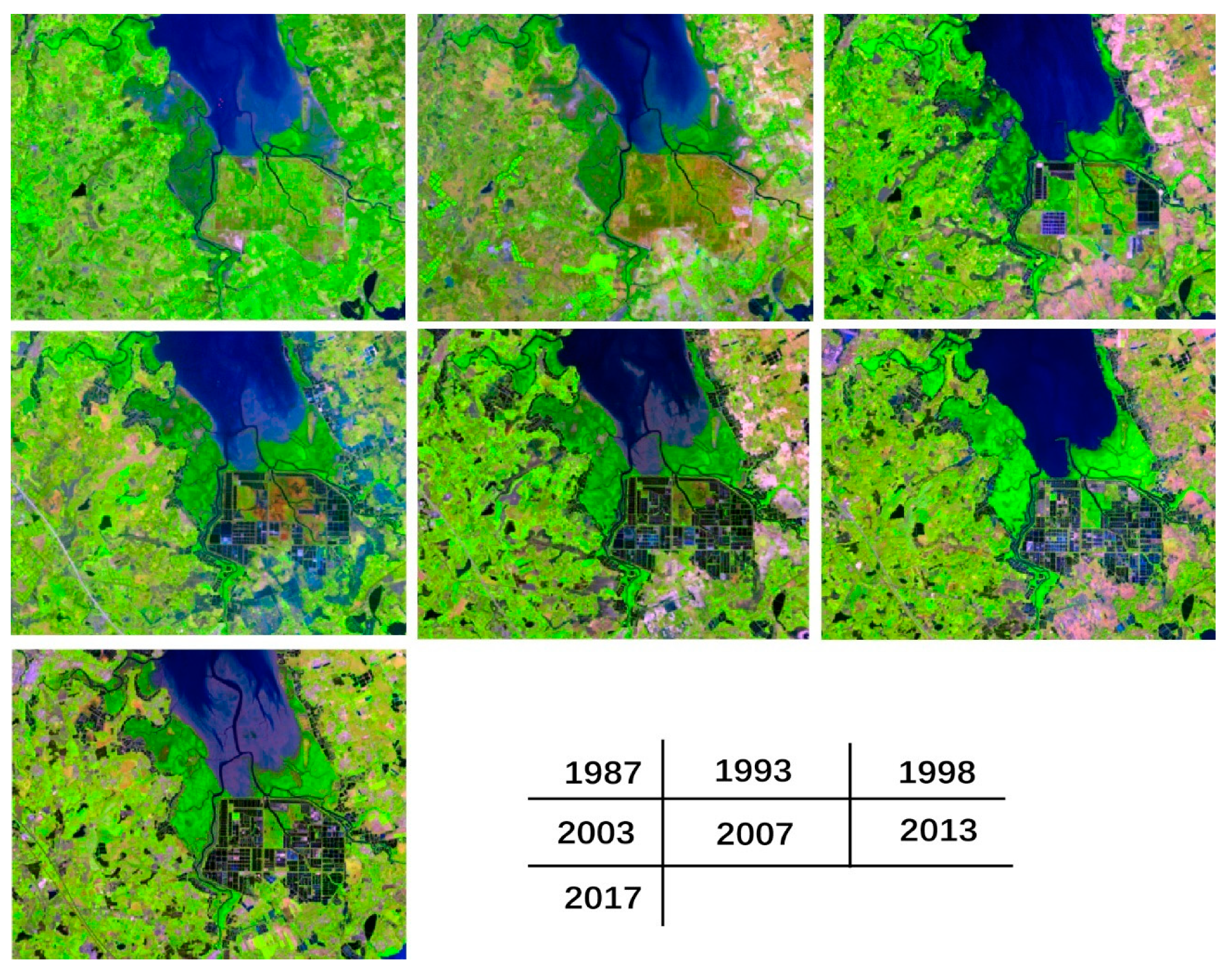

| Site | Declared Year | Declared Area (ha) | Jurisdiction | Number of Mangrove Species * |
|---|---|---|---|---|
| Dongzhaigang | 1980 | 3337 | International/National | 25 |
| Qinglangang | 1981 | 2948 | Provincial | 35 |
| Xinyinggang | 1986 | 350 | Local | 12 |
| Maniaogang | 1992 | 696 | Local | ND ** |
| Huachangwan | 1995 | 150 | Local | 12 |
| Xinyingwan | 1992 | 115 | Local | 16 |
| Dongfang | 2006 | 1429 | Provincial | ND |
| OA (%) | Kappa | Mangrove | Non-Mangrove | ||
|---|---|---|---|---|---|
| PA (%) | UA (%) | PA (%) | UA (%) | ||
| 98.8 | 0.98 | 98.3 | 99.0 | 99.1 | 98.6 |
| Site | 1987 | 1993 | 1998 | 2003 | 2007 | 2013 | 2017 |
|---|---|---|---|---|---|---|---|
| Dongzhaigang | 1466 | 1532 | 1612 | 1666 | 1729 | 1788 | 1733 |
| Qinglangang | 1656 | 1447 | 1328 | 1165 | 1150 | 1214 | 1174 |
| Xinyinggang | 415 | 330 | 305 | 294 | 263 | 276 | 291 |
| Maniaogang | 66 | 56 | 34 | 46 | 51 | 96 | 96 |
| Huachangwan | 454 | 397 | 341 | 257 | 219 | 322 | 300 |
| Xinyingwan | 623 | 760 | 723 | 483 | 478 | 577 | 607 |
| Dongfang | 36 | 25 | 38 | 30 | 60 | 67 | 77 |
| Total | 4716 | 4547 | 4381 | 3940 | 3950 | 4340 | 4278 |
| Site (Years of Mapping in Brackets) | MFDC (2015) | WMF (2000) | WAM10 (2000) | Jia (2013) | Zhang (2013) | Wu (2010) |
|---|---|---|---|---|---|---|
| Dongzhaigang | 1586 | 1629 | 1799 | 1975 | 1673 | 2007 |
| Qinglangang | 934 | 983 | 1108 | 545 | 1627 | |
| Xinyinggang | 338 | 120 | 313 | |||
| Xinyingwan | 411 | 163 | 370 | |||
| Huachangwan | 212 | 132 | 44 | 212 | ||
| Dongfang | 4 | 39 | 41 | |||
| Maliaogang | 70 | 11 | 25 | |||
| Total | 3555 | 3077 | 3700 | 1975 | 2218 | 3846 |
| Total of this study (years of mapping in brackets) | 4278 (2017) | 3940 (2003) | 3940 (2003) | 4340 (2013) | 4340 (2013) | 3950 (2007) |
| Average * | 3917 | 3509 | 3820 | 3158 | 3729 | 3898 |
| Used data sources | Landsat &Sentinel-1A | Landsat | Landsat | Landsat | Landsat | Landsat &HJ-1 |
© 2019 by the authors. Licensee MDPI, Basel, Switzerland. This article is an open access article distributed under the terms and conditions of the Creative Commons Attribution (CC BY) license (http://creativecommons.org/licenses/by/4.0/).
Share and Cite
Liao, J.; Zhen, J.; Zhang, L.; Metternicht, G. Understanding Dynamics of Mangrove Forest on Protected Areas of Hainan Island, China: 30 Years of Evidence from Remote Sensing. Sustainability 2019, 11, 5356. https://doi.org/10.3390/su11195356
Liao J, Zhen J, Zhang L, Metternicht G. Understanding Dynamics of Mangrove Forest on Protected Areas of Hainan Island, China: 30 Years of Evidence from Remote Sensing. Sustainability. 2019; 11(19):5356. https://doi.org/10.3390/su11195356
Chicago/Turabian StyleLiao, Jingjuan, Jianing Zhen, Li Zhang, and Graciela Metternicht. 2019. "Understanding Dynamics of Mangrove Forest on Protected Areas of Hainan Island, China: 30 Years of Evidence from Remote Sensing" Sustainability 11, no. 19: 5356. https://doi.org/10.3390/su11195356
APA StyleLiao, J., Zhen, J., Zhang, L., & Metternicht, G. (2019). Understanding Dynamics of Mangrove Forest on Protected Areas of Hainan Island, China: 30 Years of Evidence from Remote Sensing. Sustainability, 11(19), 5356. https://doi.org/10.3390/su11195356








